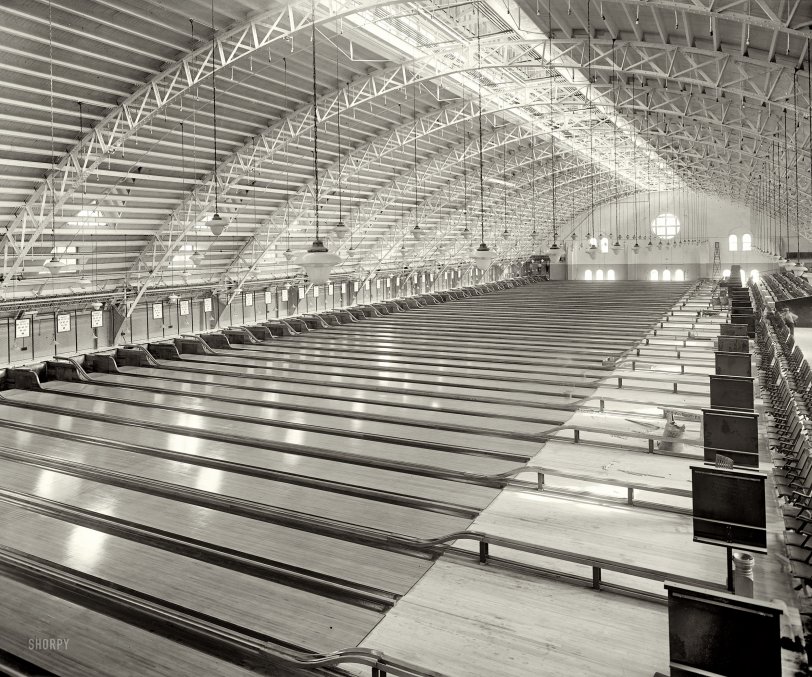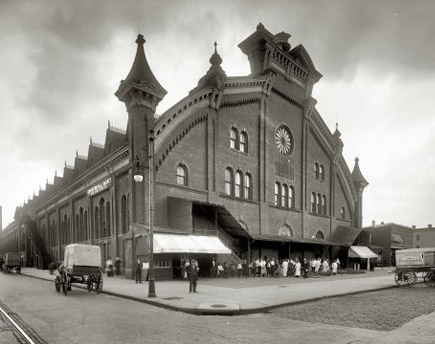


Framed or unframed, desk size to sofa size, printed by us in Arizona and Alabama since 2007. Explore now.
Shorpy is funded by you. Patreon contributors get an ad-free experience.
Learn more.

- Freeze Frame
- Texas Flyer wanted
- Just a Year Too Soon
- WWII -- Replacing men with women at the railroad crossing.
- Yes, Icing
- You kids drive me nuts!
- NOT An Easy Job
- I wonder
- Just add window boxes
- Icing Platform?
- Indiana Harbor Belt abides
- Freezing haze
- Corrections (for those who care)
- C&NW at Nelson
- Fallen Flags
- A dangerous job made worse
- Water Stop
- Passenger trains have right of way over freights?
- Coal
- Never ceases to amaze me.
- Still chuggin' (in model form)
- Great shot
- Westerly Breeze
- For the men, a trapeze
- Tickled
- Sense of loneliness ...
- 2 cents
- Charm City
- What an Outrage
- Brighton Park
Print Emporium
Washington Lanes: 1925

Washington, D.C., circa 1925. "Convention Hall bowling alleys, Fifth and K Sts." National Photo Company Collection glass negative. View full size.
That location today
For those who are always wondering as I what those locations look like today, see this.
Setters beware!
I remember bowling as a kid in Michigan. The place used pin setters and because I threw the ball so hard my dad used to have to pay the setters extra to work my lane. This was in the late 50's and by then they had a rack they loaded with pins. They sat on a raised platform between the lanes and flying pins were a hazard when I bowled.
It wasn't till later in life I learned that ball revolution and angle of attack were better for scoring than speed. By then the bowling center had converted to automatic pin setters thus depriving the manual setters my new found knowledge.
Acoustics
Although this hall would be noisy when many bowling lanes were being used, I think the height and shape of the ceiling, plus the protruding joists, would make it less noisy than more modern halls designed with low, flat ceilings.
Big Three
Today there are three bowling alleys in D.C. Lucky Strike in Chinatown, the Hippodrome on GWU's campus, and in the White House.
Had to be fast
To set up more than two lanes and get out of the way of flying pins. The pin boys I saw in the early 50's at least had a pin placer machine that they manually filled up with the pins after each roll. They would pull the pin setter down to reset them and then would crouch in a opening between lanes untill the pins quit flying. In my memory the pin boys only worked two active lanes at a time.
Contrast
I'm struck by the stark contrast between that exterior and that amazing interior! It must have really been a shock to a first time visitor to enter that building and see nothing that suggests what that wonderful exterior shell was hiding! Marvelous. Since it was converted from the market to this sports venue, kudos also to the unknown Architect that pulled it off.
Pinsetting
Hubby was a pin setter in the late '50s, early '60s. He said the pin setter would have been sitting on the flat platform on the side of the pin area. They stepped on a lever which raised pins and set the wooden bowling pins on them (therefore, PIN boys), the bowling pins had a hole drilled in the bottom. After setting them up, they released the pin and it dropped and the next frame could be played. Had to be very fast. He said if they were good enough, one boy could have done several of these lanes himself.
Pin boy protection.
I can now see that there is a walkway behind the fence. I had initially seen the floor behind the fence as being the height of the ledge. But boy going in and out of multiple lanes via sliding doors would have been slow as well as dangerous since you could not see that some idiot had not thrown another ball down the alley after you crouched. I think that little raised platform every other lane is where they stand. Each ball return serves two lanes.
I have little visual experience with pin boys but all I have seen sat/stood above the lanes on a bench so they were clear unless a pin flew high.
Pin-Spiller Paradise
Washington Post, Aug 9, 1925Huge Alleys Will Open in Fall
Convention Hall Converted Into Large Recreation Center.
At a cost of Approximately $200,000, the second floor of the old Convention hall building on Fifth, and L streets northwest, is being converted into the finest bowling center in the United States, Canada, or any other bowling country.
It is to be thrown open to the public on September 15, and will have 50 alleys, a grandstand that will seat more than 2,500 visitors, and will cover not less than 50,000 square feet of floor space.
The work of installing the alleys is being done by experts from the Brunswick-Balke factory of Muskegon, Michigan, and is under the personal supervision of John S. Blick, former bowling champion of the District of Columbia; and president and general manager of the Convention Hall Bowling Alleys.
A decided innovation in the construction of the alleys is the shower baths and rest rooms for the women bowlers; and the shower baths and smoking rooms for the men. In the balcony, overlooking the alleys, will be committee rooms for the league members in which meetings may be held. This will also contain a lounge for viewing the play on the vast array of alleys. Two thousand incandescent electric lights will furnish the illumination at night. ...
Washington Post, Aug 16, 1925B.Y.P.U. Signs For New Alleys
The Baptist Young Peoples Union is the first organization to sign up for the use of the new Convention hall bowling alleys, was the announcement yesterday of President John S. Blick, following a meeting of the board of directors. This organization consists of 24 teams, twelve of men and twelve of women. Approximately 180 teams have already signed up, and many more have made applications.
...
The new alleys are to open Monday September 14, and an excellent program is being arranged which is to include a band concert, exhibitions, and souvenirs for the ladies.
Washington Post, Jan 1, 1926Bowlers in Finals at Convention Hall
The finals of the elimination bowling tournament in progress at the Convention Hall drives will be rolled tonight, starting at 8 o'clock. Four pin-spillers remain in the event — Al Work, Max Rosenberg, Happy Burtner and John Pappas.
A semifinal of five games will be rolled by this quartet; with the low two dropping out and the two high scorers then engaging in a five-game final for first and second place.
No sliding doors for pinboys
The pinboys in old time bowling alleys had a small ledge behind the pins that they sat on, then jumped into the pit to do their work. No chain link fences. I bowled in places like this as a kid. Those are above ground ball returns and it looks like some sort of blackboard and chalk being used to keep score. Also, there are no arrows on the lane in front on the foul line to aim at. I bowled at a place in Chicago that was like that(Petersen Tournament). After we finished bowling we would tip the pinboys by throwing coins down the alley. Thanks for a great photo, Dave.
Northern Liberty Market
Wasn't the wax museum on this site in the 1960s? Convention Hall was built as the Northern Liberty Market in 1875. It burned in the mid-1940s. Seen here previously on Shorpy. Click to enlarge.
Can you imagine
the noise in that place when it was busy !!
Pin boy protection
I think the pin boys would be behind the chain link fence. There's probably a sliding door to give them access to the "pit" behind the pins. After the bowler rolled the ball, he could set the pins and return the ball. This would allow each pin boy to service several alleys.
Pin boys look out!
Man, there is no protection or space for the pin boys in this design. Lots of nice maple flooring - wish I had some of it.
Pre-AMF
Before automation put about a dozen pin setters out of work.
Inspiration
Did the architects of the Metro stations visit this place before making their designs?

























On Shorpy:
Today’s Top 5